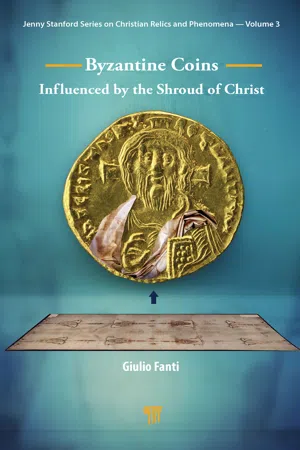
Byzantine Coins Influenced by the Shroud of Christ
Giulio Fanti
- 354 pages
- English
- ePUB (adapté aux mobiles)
- Disponible sur iOS et Android
Byzantine Coins Influenced by the Shroud of Christ
Giulio Fanti
À propos de ce livre
Numerous studies have been carried out on Byzantine coins, but there are still no univocal interpretations on the details of the figures represented there and in particular on those relating to Jesus Christ. The information derived from the studies on the Holy Shroud, the most important Relic of Christ in Christianity, has clearly resulted in some new interpretations.
This is the first book in the world that deals extensively with the effigy of Christ, despite being the most sought after and collected by numismatists. Furthermore, the book relates the different images of the Redeemer on Byzantine coins with the image of Jesus Christ on the Shroud, the most important Relic of Christianity. The numerous collectors will therefore be interested in having not only a numismatic analysis of these coins but also a historical-religious study. This book, which should be understandable to everyone, demonstrates the strong influence that the Shroud had in the Byzantine era.
Foire aux questions
Informations
Chapter 1
Byzantine Coinage
1.1 Byzantine Coinage Overview
| Period | Denomination | Metal | Weight [g] | Purity | Exchange ratio |
|---|---|---|---|---|---|
| I | Solidus-Nomisma | Gold | 4.55 | ≈100% | 1 |
| Approx. | Semissis | Gold | 2.27 | ≈100% | 2 |
| 550 | Tremissis | Gold | 1.52 | ≈100% | 3 |
| Hexagram | Silver | 6.7 | 12 | ||
| Follis | Copper | 288 | |||
| Half-Follis | Copper | 576 | |||
| Decanummium | Copper | 1152 | |||
| Pentanummium | Copper | 2304 | |||
| Nummus | Copper | 11520 | |||
| II Approx. 550–1092 | Solidus or Hista-menon Nomisma | Gold or Electrum | 4.55 | 11% (Electrum) up to ≈100% | 1 |
| Semissis | Gold | 2.27 | ≈100% | 2 | |
| Tremissis | Gold | 1.52 | 100% | 3 | |
| Tetarteron | Gold | ≈4 | 90% | 1 | |
| Hexagram | Silver | 6–6.7 | 12 | ||
| Miliaresion | Silver | 2.3–3.0 | 12 | ||
| 2/3 or 1/3 of Miliaresion | Silver | 18 or 36 | |||
| Follis | Copper | 288 | |||
| Fraction of Follis | Copper |
| Period | Denomination | Metal | Weight [g] | Purity | Exchange ratio |
|---|---|---|---|---|---|
| III 1092–1204 | Hyperpyron-Nomisma | Gold | 4.55 | 98–60% | 1 |
| Nomisma Trachy | Electrum | 4.55 | 10–30% gold | 3–12 | |
| Aspron Trachy | Billon* | 4.55 | copper–silver | 48–384 | |
| Tetarteron | Copper | 4 | ≈864 | ||
| Half-Tetarteron | Copper | 2 | ≈1728 | ||
| IV 1204–1367 | Hyperpyron-Nomisma | Gold | ≈4.5 | 50–60% | 1 |
| Basilikon | Silver | ≈2 | 12 | ||
| Tournesion | Billon | 96 | |||
| Aspron Trachy | Billon | 0.75 | 384 | ||
| Assarion | Copper | 3–4 | 768 | ||
| V | Hyperpyron | Gold | ≈4 | 1 | |
| 1367–1453 | Stavraton | Silver | 7–9 | 2 | |
| Half-Stavraton | Silver | 3–5 | 4 | ||
| Ducat | Silver | 1.1 | 16 | ||
| Tournesion | Copper | ≈2.4 | 192 | ||
| Follaro | Copper | ≈0.8 | ≈576 | ||
*The billon is an alloy used for coinage, containing silver (or gold) with a predomi... | |||||